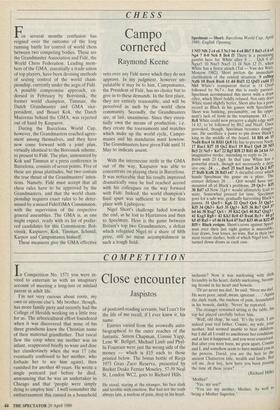CHESS
Campo cornered
Raymond Keene
Er several months confusion has reigned over the outcome of the long running battle for control of world chess between two competing bodies. These are the Grandmaster Association and Fide, the World Chess Federation. Leading mem- bers of the GMA, essentially a trade union of top players, have been devising methods of seizing control of the world cham- pionship, currently under the aegis of Fide. A possible compromise approach, en- dorsed in February by Botvinnik, the former world champion, Timman, the Dutch Grandmaster and GMA vice- president, and Bessel Kok, the Dutch Maecenas behind the GMA, was rejected out of hand by Kasparov.
During the Barcelona World Cup, however, the Grandmasters reached agree- ment among themselves, and they have now come forward with a joint plan, virtually identical to the Botvinnik scheme, to present to Fide. The plan, announced by Kok and Timman at a press conference in Barcelona, consists of seven points. Five of these are pious platitudes, but two contain the true thrust of the Grandmasters' inten- tions. Namely, Fide must accept that all chess rules have to be approved by the Grandmasters, and that the world cham- pionship requires exact rules to be deter- mined by a mixed Fide/GMA Commission, with the supervision of the respective general assemblies. The GMA is, as one might expect, ready with its list of prefer- red candidates for this Commission: Bot- vinnik, Kasparov, Kok, Timman, Schmid, Karpov and Campomanes himself.
These measures give the GMA effective veto over any Fide move which they do not approve. In my judgment, however un- palatable it may be to him, Campomanes, the President of Fide, has no choice but to give in to these demands. In the first place, they are entirely reasonable, and will be perceived as such by the world chess community. Secondly, the Grandmasters are, at last, unanimous. Since they essen- tially own the means of production, i.e. they create the tournaments and matches which make up the world cycle, Campo- manes and his mandarins must kowtow. The Grandmasters have given Fide until 31 May to indicate assent.
With the internecine strife in the GMA out of the way, Kasparov was able to concentrate on playing chess in Barcelona. It was noticeable that his results improved dramatically once he had reached accord with his colleagues on the way forward with Fide. Indeed, the world champion's final spurt was sufficient to tie for first place with Ljubojevic.
Nigel Short's challenge faded towards the end, as he lost to Hjartarson and then to Speelman. Here is the game between Britain's top two Grandmasters, a defeat which relegated Nigel to a share of fifth prize, still no mean accomplishment in such a tough field.
Speelman — Short: Barcelona World Cup, April 1989; English Opening.
1 Nf3 Nf6 2 c4 e6 3 Nc3 b6 4 e4 Bb7 5 Bd3 c5 6 e5 Ng4 7 0-0 Nc6 8 Be4 f5 There is a promising gambit here for White after 8 . . . Qc8 9 d3 Ngxe5 10 Nxe5 Nxe5 11 f4 Nc6 12 15, when White has a fierce attack (Tat — Van der Wiel, Moscow 1982). Short prefers the immediate clarification of the central situation. 9 exf6eP Nxf6 10 Bxc6 Bxc6 11 d4 Bxf3 12 Qxf3 cxd4 13 Nb5 White's transparent threat is 14 Qxa8 followed by Nc7+ , but this is easily parried. Speelmanaccompanied this move with a draw offer, which Short boldly refused. Not only does White stand slightly better, Short also has a poor record as Black in his games with Speelman. Short was banking, presumably, on his oppo- nent's lack of form in the tournament. 13 . • • Rc8 White could now preserve a slight edge with 14 b3, to be followed by Bb2 and Nxd4. Once provoked, though, Speelman becomes danger- ous. He sacrifices a pawn to pin down Black's king in the middle of the board. 14 Bf4 a6 15 Nxd4 Rxr4 16 Rfdl Qc8 He has to prevent Nxe6. 17 Racl K17 18 Qe2 Rxcl 19 Rxcl Qa8 20 NO Bc5 21 Ne5+ Ke7 22 Bg5 Rf8 23Rd! d6 24 b4 imaginative stroke, intending to reply to 24. • • Bxb4 with 25 Qg4. In that case White has a powerful attack, though not necessarily a deci- sive one. 24 . . . dxe5 25 bxc5 bxc5 26 Qc2 27 Bxf6 Kxf6 28 Rd3 e4? A dreadful error which hands Speelman the game on a plate. The correct defence 28 . . . 0c6 would have sur- mounted all of Black's problems. 29 Qc3+ KfS 30 Rd7 e3 Now 31g4+ would ultimately lead to mate. Somewhat pressed for time, Speelman goes for a safe win, gradually harvesting Black's pawns. 31 Qxc5+ Kg6 32 Qxe3 Qc6 33 Qg3+„ Kf5 34 Qh3+ Ke5 35 Qg3+ Kf5 36 Rc7 Qe4 / h4 h6 38 Rxg7 Qel+ 39 Kh2 Qe5 40 Ra7 Qxg3+ 41 Kxg3 Rg8+ 42 Kh3 Rc8 43 Rxa6 Rc3+ 44 83 h5 45 Ra5+ e5 46 f4 Ke4 47 fxe5 Kf3 48 e6 Kf2 49 Rf5+ Black resigns. Short's score against Spat" man over their last eight games is miserable, four draws, four losses, no wins. But in their two most recent clashes, both of which Nigel lost, be turned down draws in each case.


















































 Previous page
Previous page